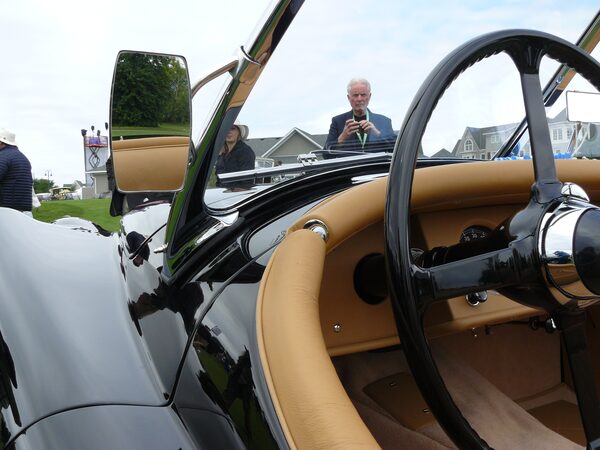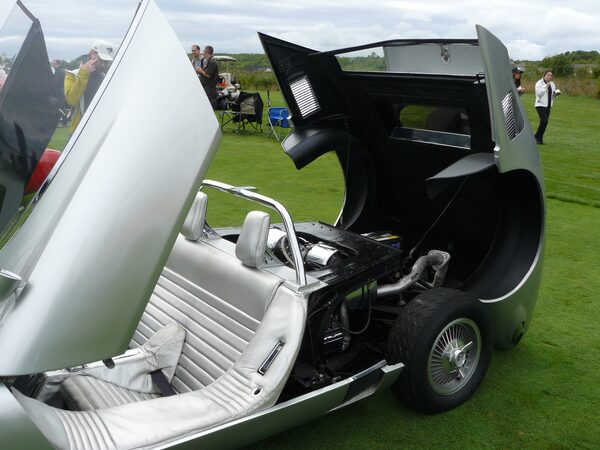In photos: The best of antique cars at this year's Concours D'Elegance
It’s the 7th year for the annual charity event, which has raised more than $500,000 for the Sunnybrook Foundation and the Owen Sound Regional Hospital Foundation.

Rain didn’t stop the cars or crowds from gathering at the Cobble Beach Concours d’Elegance in Kemble, north of Owen Sound, Ontario last weekend. More than 11,000 car lovers came out to get a glimpse of some of the world’s rarest and most exotic classic cars. It’s the 7th year for the annual charity event, which has raised more than $500,000 for the Sunnybrook Foundation and the Owen Sound Regional Hospital Foundation. This year, more than one hundred vehicles graced the 18th fairway of the Cobble Beach Golf Links overlooking Georgian Bay -- each vehicle with unique design features rarely seen on modern cars today.Petrina Gentile/The Globe and Mail

This is a mechanic’s dream car. This 1969 Dodge Super Bee A12 has a black lift-off roof that makes it easy to tinker with the heart of this muscle car. Under the hood is a massive 440-cubic inch Magnum engine with a “six-pack” of carbs. It was an affordable, performance machine for the day. Dodge built only 1,907 Super Bee A12 coupes and hardtops.Petrina Gentile/The Globe and Mail

1954 MG TF: The sculpted sweeping dashboard is beautifully finished in a classic, elegant, biscuit colour. A rear-view mirror takes centre stage, positioned directly on the dashboard - not exactly the best place for rear-view visibility. But design wise, it was the ideal spot since this 1954 MG TF roadster had a tiny windshield and a folding convertible top for open-air cruising. This vehicle was bought in Brussels, Belgium by an American.Petrina Gentile/The Globe and Mail

There’s no denying this Rolls-Royce Phantom III is the pinnacle of elegance and sophistication. It even comes with a bar in the back for the two rear-seat passengers. Crystal glasses and decanters store nicely away when not in use. For privacy, a glass partition divided the front passengers from the rear. It wasn’t power operated - it was manually operated. A rotating handle let back-seat riders lower the window to talk with the driver when needed.Petrina Gentile/The Globe and Mail

You might think there’s a clutch in this 1912 Ford Model T Touring, but that’s not the case. The three floor mounted pedals have different roles. The pedal on the right is the brake. The centre pedal is reverse. The left pedal is the low and high gear. Powering the Model T is a planetary transmission, similar to a two-speed transmission. Ford used this version in early vehicles right up until 1927.Petrina Gentile/The Globe and Mail

It’s impossible to miss this 1932 Plymouth PB convertible thanks to its two-tone lime and evergreen colours. The exterior paint shade was chosen by a previous owner, Sharon Taylor. Originally all of these vehicles were painted blue, but you could customize the colour to your liking for an extra $60. Back in 1932, this convertible cost $785. Only 690 were built in its short, one-year production run.Petrina Gentile/The Globe and Mail

Toronto owner Regan O’Halloran found this tan, plaid mat to line the trunk of his 1970 Ford Torino Cobra - named after the city of Turin in Italy. It’s a period-correct version of the vinyl cargo mat that came in the Torino. Like the original, it doesn’t mould perfectly into place in the corners. But at least the vinyl material is washable; it peels back easily to make it a cinch to remove and clean. The Ford Torino was named Motor Trend’s coveted “Car of the Year” in 1970.Petrina Gentile/The Globe and Mail

Look closely and you’ll spot a design detail added to this iconic 1954 Jaguar XK120 SE roadster - side-view mirrors. You won’t find them on the original two-seater. Quebec owner Stephane Mondou bought this Jag in 2016 for about $35,000 and paid a few hundred dollars extra to add the mirrors for better visibility. Other trademark design features include dual windshields, a tiny rear-view mirror on the dashboard, and no visible outside door handles -- unique features that give this Jag its stunning, elegant look.Petrina Gentile/The Globe and Mail

In 1930, this Packard 745 roadster came in a short 140-inch wheelbase version and this longer, more expensive 145-inch wheelbase model. The longer wheelbase is coveted by classic car collectors these days. The extra 5-inch-wheelbase provides a longer, more elegant fender line and extra interior space. Another distinct feature is the roof - it wasn’t flat. It was cut upright so that passengers had more headroom when driving around with the top closed.Petrina Gentile/The Globe and Mail

Who needs a power sunroof? Going topless in this 1948 Rolls-Royce Silver Wrath Sedanca de Ville takes a bit of time, elbow grease, and patience. The full-solid roof hides away nicely when not in use for a true convertible feel. On a rainy day, the side panels snap into place at the front and the hard-top roof slides forward to make it a hard-top limousine. The Silver Wrath were the first cars Rolls-Royce built after the war.Petrina Gentile/The Globe and Mail

This 1962 Chevrolet Corvair Monza GT was a one-off - a concept car built by General Motors to showcase the future of the automobile. The design was unique - the back of the car hinges upward so it’s easy to view the turbocharged six-cylinder engine, positioned in the rear. The wraparound cover over the cabin opens forward to make it easier to get inside the two sculpted seats. Today, this concept is estimated to be worth $8 million.Petrina Gentile/The Globe and Mail